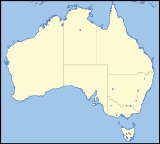
Hallett Cove Conservation Park
Encyclopedia
Hallett Cove Conservation Park is a conservation park in Hallett Cove, South Australia
. It is located on the shore of Gulf Saint Vincent
, 22 km south of central Adelaide
.
Professor Ralph Tate realised that South Australia had been subjected to an ice age
when in 1875 he discovered the area's smoothed and striated glacial
pavement.
Subsequent geological work demonstrated that during the Permian
, Australia was closer to the south pole than today while part of the Gondwana
n supercontinent. During that time the south-western two-thirds of Australia, including much of South Australia was covered by an ice sheet
.
In 1957 Professor AR Alerman from the University of Adelaide wrote to the National Trust recommending that the glacial pavements along the coastal cliff tops of Hallett Cove be preserved. For the next 19 years conservationists fought against housing developments until 1976, when the park was dedicated for the protection of features of geological and historic interest.
Hallett Cove, South Australia
Hallett Cove is a coastal suburb in the south of Adelaide, South Australia, with a population of more than 12,000 people. Adjoining suburbs are Marino to the north, Trott Park and Sheidow Park to the east and Lonsdale to the south. It is within the City of Marion Local Government Area...
. It is located on the shore of Gulf Saint Vincent
Gulf Saint Vincent
Gulf St Vincent is a large inlet of water on the southern coast of Australia, in the state of South Australia. It is bordered by Yorke Peninsula to its west coast and Fleurieu Peninsula on its east coast. Kangaroo Island sits across the opening to the Southern Ocean on the southwest.Adelaide, the...
, 22 km south of central Adelaide
Adelaide
Adelaide is the capital city of South Australia and the fifth-largest city in Australia. Adelaide has an estimated population of more than 1.2 million...
.
History
Aboriginal stone implements were first discovered in Hallett Cove in 1934 with more than 1,700 artefacts being collected over a period of 30 years. Farming began in what is now the eastern section of the park in the 1850s.Professor Ralph Tate realised that South Australia had been subjected to an ice age
Ice age
An ice age or, more precisely, glacial age, is a generic geological period of long-term reduction in the temperature of the Earth's surface and atmosphere, resulting in the presence or expansion of continental ice sheets, polar ice sheets and alpine glaciers...
when in 1875 he discovered the area's smoothed and striated glacial
Glacier
A glacier is a large persistent body of ice that forms where the accumulation of snow exceeds its ablation over many years, often centuries. At least 0.1 km² in area and 50 m thick, but often much larger, a glacier slowly deforms and flows due to stresses induced by its weight...
pavement.
Subsequent geological work demonstrated that during the Permian
Permian
The PermianThe term "Permian" was introduced into geology in 1841 by Sir Sir R. I. Murchison, president of the Geological Society of London, who identified typical strata in extensive Russian explorations undertaken with Edouard de Verneuil; Murchison asserted in 1841 that he named his "Permian...
, Australia was closer to the south pole than today while part of the Gondwana
Gondwana
In paleogeography, Gondwana , originally Gondwanaland, was the southernmost of two supercontinents that later became parts of the Pangaea supercontinent. It existed from approximately 510 to 180 million years ago . Gondwana is believed to have sutured between ca. 570 and 510 Mya,...
n supercontinent. During that time the south-western two-thirds of Australia, including much of South Australia was covered by an ice sheet
Ice sheet
An ice sheet is a mass of glacier ice that covers surrounding terrain and is greater than 50,000 km² , thus also known as continental glacier...
.
In 1957 Professor AR Alerman from the University of Adelaide wrote to the National Trust recommending that the glacial pavements along the coastal cliff tops of Hallett Cove be preserved. For the next 19 years conservationists fought against housing developments until 1976, when the park was dedicated for the protection of features of geological and historic interest.
External links
- Hallett Cove Conservation Park Marion Council
- Hallett Cove Conservation Park South Australia Department of Environment and Natural Resources. This site includes a pamphlet containing a map of the walking trails.
- A field guide to the geology of Hallett Cove. Field Geology Club of South Australia. 1999. Available by mail from the Club or from the bookshop of the South Australia Museum.

